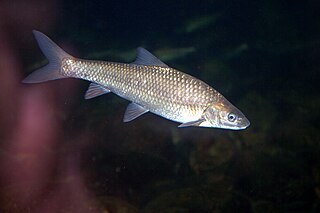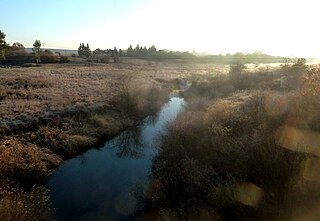Related Research Articles

The Orange River is a river in Southern Africa. It is the longest river in South Africa. With a total length of 2,432 km (1,511 mi), the Orange River Basin extends from Lesotho into South Africa and Namibia to the north. It rises in the Drakensberg mountains in Lesotho, flowing westwards through South Africa to the Atlantic Ocean. The river forms part of the international borders between South Africa and Lesotho and between South Africa and Namibia, as well as several provincial borders within South Africa. Except for Upington, it does not pass through any major cities. The Orange River plays an important role in the South African economy by providing water for irrigation and hydroelectric power. The river was named the Orange River in honour of the Dutch ruling family, the House of Orange, by the Dutch explorer Robert Jacob Gordon. Other names include simply the word for river, in Khoekhoegowab orthography written as !Garib, which is rendered in Afrikaans as Gariep River with the intrusion of a velar fricative in place of the alveolar click, Groote River or Senqu River, derived from ǂNū "Black". It is known in isiZulu as isAngqu.

The Breede River, also known as Breë River, is a river in the Western Cape Province of South Africa. Travelling inland north from the city of Cape Town, the river runs in a west to east direction. The surrounding western mountains formed the first continental divide experienced by European settlers in the 18th century. The Titus River and Dwars River become the Breë River.

The R27 is a provincial route in South Africa that consists of two disjoint segments. The first segment, also known as the West Coast Highway, connects Cape Town with Velddrif along the West Coast. The second runs from Vredendal via Vanrhynsdorp, Calvinia, Brandvlei and Kenhardt to Keimoes on the N14 near Upington. The connection between Velddrif and Vredendal has never been built, although it can be driven on various gravel roads.

The R43 is a provincial route in the Western Cape province of South Africa which connects Ceres with Gansbaai via Worcester, Botrivier and Hermanus. It is co-signed with the N2 for nine kilometres near Botrivier.

The R353 is a Regional Route in South Africa that connects Leeu-Gamka with Brandvlei via Fraserburg and Williston.

The Cape whitefish or Berg-breede River whitefish is a ray-finned fish species in the family Cyprinidae. It is placed with the South African redfins in Pseudobarbus. It is tetraploid. Its closest living relative was at one time considered the sawfin.

Chrysoritis rileyi, the Riley's opal, is a species of butterfly in the family Lycaenidae. It is endemic to South Africa, where it is known only from hill slopes and river flats at the east end of the Brandvlei Dam in the Western Cape.

Kenhardt is a small town in the Northern Cape province of South Africa. This little town is about 120 km from Upington, the largest town in the area.
Brandvlei is a small town in the Karoo region of the Northern Cape, South Africa. This is where a 19th-century trekboer called Ou Brand settled. Brand camped at this spot at the Sakrivier, a dry river bed, which only occasionally had water after good rains – and which typically result in flash floods. The settlement was cut in two by such a flood in 1961. After it was recovered, a municipality was formed in 1962.

The Berg River Dam is a 68-metre (223 ft) high dam on the Berg River in South Africa. It is the centerpiece of the Berg Water Project (BWP) which is designed to capture the winter rainfall and store it for supply to Cape Town during the dry summer months. The project in turn forms an important part of the Western Cape Water Supply System (WCWSS), an intricate system of dams and bulk water infrastructure that provides water to more than 3 million people. At the inauguration of the dam in 2009, then President of South Africa Kgalema Motlanthe called the project "a good example of how public infrastructure projects can be used to contribute meaningfully to poverty eradication and to foster social empowerment of the people." The Berg River Dam was the first dam in South Africa to be designed and constructed, and is due to be operated, in accordance with the guidelines of the World Commission on Dams. It has been completed on time and within budget. The Berg River basin and the adjacent metropolitan area of Cape Town are of particular importance to the Western Cape region because, although the basin generates only about 3% of the country's water resources, it is home to about 8% of South Africa's population, and produces about 12% of GDP.
Breede WMA, or Breede Water Management Area , Includes the following major rivers: the Breede River, Riviersonderend River, Sout River, Bot River and Palmiet River, and covers the following Dams:
Brandvlei Dam is an earth-fill type dam on the Lower Brandvlei River in Western Cape, South Africa. It was completed in 1983 and the inlet is the Holsloot River.

Woodhead Dam is a dam on Table Mountain, Western Cape, South Africa. It was built in 1897 and supplies water to Cape Town. The dam, which was the first large masonry dam in South Africa, was designated as an International Historic Civil Engineering Landmark by the American Society of Civil Engineers in 2008.

The Crocodile River is a river in South Africa. At its confluence with the Marico River, the Limpopo River is formed.

The Wilge River (iKuthu) is a river in Mpumalanga and Gauteng provinces, South Africa. It is a tributary of the Olifants River.
The Vaal River Barrage Reservoir is a dam on the Vaal River near Vanderbijlpark, border Gauteng and Free State, South Africa.
Brandvlei Correctional Centre is a prison situated on the bank of the Brandvlei Dam near Worcester, Western Cape, South Africa. It contains a maximum-security unit, a medium-security unit, and a juvenile unit. The facility also houses members of the notorious The Numbers Gang or numbers gangs. In 2021, it was featured in a Netflix series, Inside the World's Toughest Prisons.
Brandvlei is a town in the Northern Cape province of South Africa.
The Hex River is a tributary of the Breede River located in the Western Cape of South Africa. The most important settlements along the river are the small towns of De Doorns and Touws River.